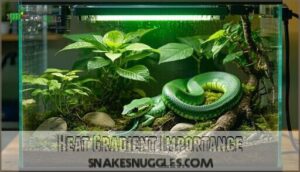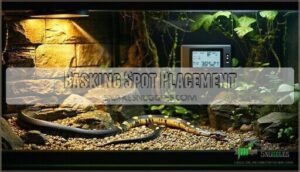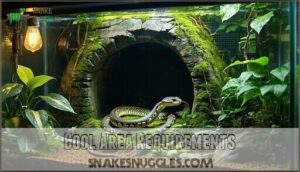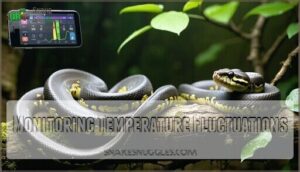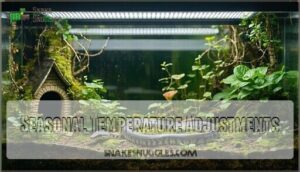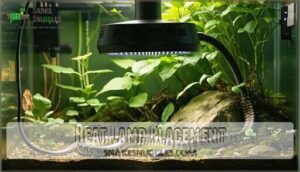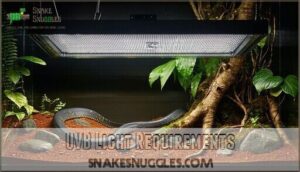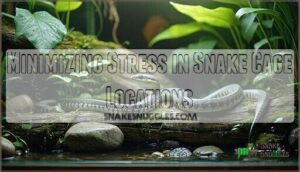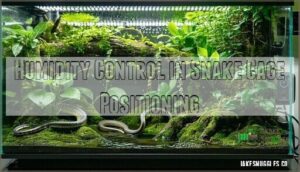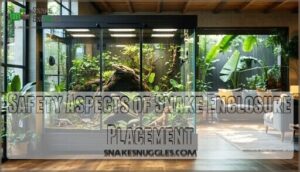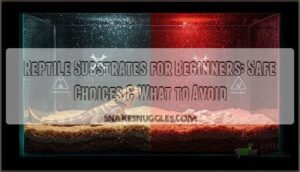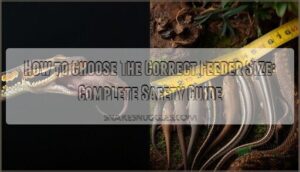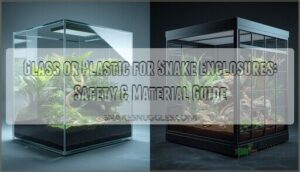This site is supported by our readers. We may earn a commission, at no cost to you, if you purchase through links.
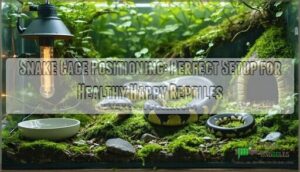
You’ll want to create a temperature gradient with your warm side hitting 88-92°F and cool side staying around 75-80°F.
Skip placing the cage near windows where direct sunlight creates dangerous hot spots, and avoid high-traffic areas that stress your snake.
The sweet spot? A stable room corner where temperature stays consistent and your scaly friend won’t get startled by daily chaos.
Getting the basics right sets the foundation for advanced techniques that make all the difference.
Table Of Contents
- Key Takeaways
- Optimal Temperature Zones for Snake Enclosures
- Lighting Considerations for Snake Habitats
- Minimizing Stress in Snake Cage Locations
- Humidity Control in Snake Cage Positioning
- Safety Aspects of Snake Enclosure Placement
- Frequently Asked Questions (FAQs)
- How do I set up a snake cage?
- How do I choose the right cage for my snake?
- Do snake cages need to be ventilated?
- How to set up a snake enclosure?
- What do you put in a snake cage?
- What are the dimensions of a snake cage?
- Where to put a snake enclosure?
- What is the rule of thumb for snakes?
- What do snakes like in their tank?
- How often should I clean my snakes cage and accessories?
- Conclusion
Key Takeaways
- Find a quiet corner away from foot traffic – You’ll reduce stress and create stable conditions by positioning your snake’s cage in low-traffic areas, such as spare bedrooms or basement corners, avoiding the chaos of daily household activities.
- Create proper temperature gradients with strategic heating – You need to establish warm zones at 88-92°F and cool areas at 75-80°F, positioning heat lamps 12-18 inches above basking spots while providing shaded retreat areas.
- Avoid direct sunlight and extreme temperature sources – You’ll prevent dangerous overheating by keeping cages away from windows with direct sun exposure and maintaining consistent room temperatures without drafts or heating vents.
- Prioritize safety with secure placement and emergency access – You should install escape-proof locks, position enclosures for easy emergency access, and keep electrical heating elements properly grounded with GFCI protection away from water sources.
Optimal Temperature Zones for Snake Enclosures
Your snake’s body works like a living thermometer, constantly seeking the perfect temperature to digest food, fight off illness, and stay active.
Creating the right temperature zones in your snake’s enclosure isn’t just helpful—it’s essential for keeping your scaly friend healthy and happy.
Heat Gradient Importance
Creating proper heat gradients transforms your snake’s home into a thermal playground where they’ll thrive.
Your reptile needs temperature zones for thermoregulation, just like you’d want different rooms in your house.
Here’s why heat gradients matter:
- Metabolic Processes – Temperature zones boost enzyme activity and energy production
- Digestion Health – Basking spots help break down food efficiently after meals
- Breeding Cycles – Microclimate variety triggers natural reproductive behaviors
Basking Spot Placement
Your snake’s basking spot needs precise heat lamp placement for ideal temperature zones.
Position heat lamps 12-18 inches above basking areas, adjusting lamp distance based on wattage selection.
Higher wattage bulbs require greater distances to prevent overheating.
Consider the importance of a quality heat source for your reptile.
Install thermostat control to maintain consistent temperatures and create proper temperature gradients.
Always provide shaded areas where your snake can escape intense heat.
Different species needs vary substantially, so research your specific snake’s requirements.
| Heat Source | Recommended Distance |
|---|---|
| 50W Heat Lamp | 8-12 inches |
| 75W Heat Lamp | 12-15 inches |
| 100W Heat Lamp | 15-18 inches |
| 150W Heat Lamp | 18-24 inches |
Cool Area Requirements
While your snake basks in warmth, it also needs cool areas to regulate body temperature effectively.
Creating proper temperature zones with a temperature gradient from 75-80°F maintains environmental stability.
Here’s how to set up perfect cool areas:
- Position cool zones opposite basking spots
- Provide shade provision using decorations or hides
- Guarantee proper ventilation prevents heat buildup
- Use monitoring equipment to track temperatures
- Research species needs for specific requirements
This setup lets your snake move between zones naturally, maintaining healthy health through thermoregulation.
Monitoring Temperature Fluctuations
Vigilance becomes your reptile’s lifeline when tracking temperature swings.
Place thermometers strategically throughout zones, using data logging systems for continuous temperature monitoring.
Remote monitoring tools track temperature fluctuations while you’re away, ensuring stable temperature gradients.
Install alarm systems that alert you when conditions drift from target ranges.
Regular thermometer calibration prevents false readings that could endanger your snake’s health.
Seasonal Temperature Adjustments
Throughout the year, your snake’s temperature needs shift like the changing seasons outside. Winter cooling triggers natural brumation behaviors, while summer heating boosts their metabolism and activity levels. Smart thermostat calibration helps you nail these gradient shifts perfectly.
Here’s your seasonal adjustment playbook:
- Winter cooling: Drop temperatures 5-10°F to mimic natural dormancy periods
- Summer heating: Increase basking zones for peak activity and digestion
- Species variation: Research your snake’s wild habitat for proper temperature regulation
Temperature gradients become your best friend during these periods of change. Maintaining the ideal temperature ranges is vital for your snake’s well-being. Heat gradients need careful monitoring as you adjust seasonal temperature zones—your snake’s health depends on getting these temperature adjustments right.
Lighting Considerations for Snake Habitats
Your snake’s lighting setup affects more than just visibility—it controls their internal clock and vitamin production.
Getting the placement right means your scaly friend stays healthy and follows natural rhythms that keep them content in their cozy home.
Heat Lamp Placement
Your heat lamp placement sets the stage for perfect temperature zones.
Position lamps 12-18 inches from your snake’s basking spot, matching bulb wattage to enclosure size.
Create distinct temperature gradients without dangerous hot spots by using thermostats and providing shade provision areas.
Smart heat sources placement means your snake controls its comfort—like having a personal thermostat!
| Heat Source Type | Basking Distance | Typical Wattage |
|---|---|---|
| Ceramic Heat Emitter | 12-15 inches | 75-150W |
| Incandescent Bulb | 15-18 inches | 60-100W |
| Halogen Spotlight | 18-24 inches | 50-75W |
| Mercury Vapor Bulb | 24-30 inches | 100-160W |
UVB Light Requirements
Beyond proper heat lamp placement, UVB lighting deserves your attention for certain snake species.
Most snakes fall under Ferguson Zone 2, requiring UVI levels of 2.0-3.0 for peak health.
UVB synthesis enables vitamin D3 production, supporting calcium absorption and preventing metabolic bone disease.
Adequate UVB also strengthens their immune systems.
Consider these UVB light requirements:
- Bulb types: Mercury vapor, fluorescent, or LED options work well
- Light spectrum: 5-10% UVB intensity suits most partial baskers
- Photoperiod length: 10-12 hours daily mimics natural cycles
- Reptile lighting placement: 10-14 inches above basking area with mesh
Replace UVB bulbs every 12 months since output declines over time.
Natural Light Exposure
While UVB lights help with UVB synthesis, natural light offers amazing natural enrichment for your snake’s circadian rhythm.
Position your snake cage near a window, but use light filtration like curtains to prevent overheating. Direct sunlight can overheat enclosures dangerously.
Filtered natural light creates perfect day-night cycles without the greenhouse effect. Your snake gets outdoor vibes safely indoors!
Proper lighting also supports calcium and growth.
Minimizing Stress in Snake Cage Locations
Positioning your snake’s cage away from high-traffic areas reduces stress and creates a calmer environment for your pet.
You’ll want to choose a quiet spot that provides consistent conditions while protecting your snake from the chaos of daily household activities, which helps in reducing stress and creating a more quiet spot.
Low-traffic Area Selection
Where should you position your snake’s cage for maximum peace? Choose a quiet location away from household hustle—think spare bedroom or basement corner.
Reduced stress comes from limited access areas where foot traffic stays minimal. Make family awareness of the setup, but keep the enclosure away from daily chaos.
Proper ventilation is also key for a healthy environment. Snake stress decreases dramatically when positioned strategically.
Noise Reduction Strategies
Most snakes handle household noise just fine, but strategic noise reduction strategies can dramatically lower snake stress levels. Think of it as creating a zen retreat for your scaly friend.
Acoustic panels and sound absorption materials around the enclosure reduce ambient noise by up to 50%. Smart cage material choices and location acoustics matter too—thicker walls provide better sound insulation than mesh sides.
Here’s your noise-busting toolkit:
- Place vibration dampening mats under cages to minimize noise transmission through floors
- Install foam panels or heavy curtains around the enclosure as effective noise barriers
- Use white noise machines to mask sudden sounds that might startle your snake
Visual Barrier Implementation
While your snake might feel like it’s hiding from paparazzi, creating visual barriers is a vital enrichment strategy for proper snake cage positioning.
Use plants, decorative screens, or fabric panels around three sides of the enclosure to establish secure hiding and territory definition.
This visual barrier implementation promotes natural behavior by providing reduced stress through sight protection, helping your snake feel like the master of its domain rather than a zoo exhibit.
Avoiding Direct Sunlight Exposure
Direct sunlight can turn your snake’s home into an oven faster than you’d think. UVB Degradation from unfiltered sun rays disrupts Spectral Balance while creating dangerous Overheating Risks.
Direct sunlight transforms snake homes into deadly ovens within minutes.
Smart snake cage positioning requires direct sunlight avoidance to maintain stable temperature zones and environmental stability**. Here’s how to protect your reptile:
- Use window films or blinds for Filtered Sunlight
- Position enclosures away from south-facing windows
- Install canopies or shade cloths over outdoor setups
- Monitor Light Duration to prevent excessive exposure
Maintaining Consistent Environment
Consistency becomes your reptile’s best friend when you establish rock-solid routines.
Maintain stable temperature zones and humidity levels around the clock, avoiding dramatic swings that stress your snake.
Set lighting schedules that mimic natural day-night cycles, while ensuring proper ventilation balance supports healthy air circulation.
Consider seasonal simulation adjustments to keep your scaly companion content year-round.
Humidity Control in Snake Cage Positioning
Positioning your snake’s cage correctly can make or break your humidity control efforts.
You’ll need to take into account room airflow, proximity to heating sources, and access to misting equipment when choosing the perfect spot to ensure effective humidity management.
Species-specific Humidity Needs
Understanding your snake’s species-specific humidity needs is like knowing their home address—tropical species like Green Tree Pythons thrive at 80-90% humidity, while desert dwellers like Rosy Boas prefer 20-40%.
Getting it wrong causes shedding problems and respiratory issues.
A compact hygrometer can assist in vivarium environmental monitoring to confirm proper conditions.
Use humidity gradients and smart substrate selection with misting techniques for perfect humidity control.
Ventilation Requirements
Fresh air circulation keeps your snake healthy and prevents respiratory issues. Without proper ventilation requirements, stagnant air creates breeding grounds for bacteria and mold.
Your airflow optimization strategy should balance humidity while ensuring respiratory health through strategic vent placement.
- Install intake vents low and exhaust vents high for natural air circulation patterns
- Use adjustable vent covers to fine-tune airflow design without losing humidity balance
- Position vents away from heat sources to prevent hot spots and maintain even temperatures
- Add quiet fans if needed for mold prevention in high-humidity setups
Misting and Fogging Systems
Beyond ventilation, misting systems and fogger types become your humidity control champions.
Ultrasonic foggers create fine mist particles, while heat-based models produce warmer vapor.
Set up automated misting schedules to maintain consistent humidity gradients without constant monitoring.
Regular system maintenance and clean water quality prevent bacterial growth that could harm your snake’s respiratory health.
To guarantee accuracy, use digital hygrometers for monitoring humidity levels.
| Fogger Type | Best For |
|---|---|
| Ultrasonic | Fine mist, quiet operation |
| Heat-based | Warmer vapor, winter use |
| Combination | Flexible humidity control |
| Automated timers | Consistent misting schedules |
| Manual spray bottles | Spot treatments, budget option |
Substrate Choices for Moisture Retention
You’ll want substrate choices that lock in moisture like a sponge.
Coconut fiber and cypress mulch excel at moisture retention, creating those humidity gradients your snake craves.
Sphagnum moss works magic in humid hides, while forest litter mimics nature perfectly.
Consider coconut fiber bedding for superior comfort.
Skip aspen for high-humidity species—it’s like using a paper towel for humidity control.
Monitoring and Adjusting Humidity Levels
Perfect substrate won’t help if you’re not tracking humidity properly. Think of your hygrometer as your snake’s personal weather station – you’ll want to check it daily like checking tomorrow’s forecast.
Here’s your humidity control game plan:
- Hygrometer calibration matters: Test your humidity gauge monthly with a salt test to guarantee accurate readings.
- Master your misting frequency: Most snakes need 2-3 weekly misting sessions, but adjust based on substrate moisture levels.
- Create humidity gradients: Maintain 30% in basking areas and up to 90% in hide boxes for natural microhabitats.
- Optimize ventilation strategies: Position intake vents low and exhaust vents high to balance airflow without losing necessary moisture.
Proper humidity level monitoring prevents respiratory issues and guarantees healthy shedding cycles.
Safety Aspects of Snake Enclosure Placement
When you position your snake’s enclosure, you’re not just creating a home—you’re building a secure fortress that protects both your snake and your household.
Proper placement means thinking through escape routes, household dangers, and emergency scenarios so you can sleep soundly knowing everyone’s safe.
Securing Against Escapes
Your snake’s getting comfortable with perfect humidity levels, but now it’s time to lock down that enclosure!
Escape-proof locks and lid security aren’t optional—they’re lifesavers.
Check for hiding gaps around edges, manage heating cord management properly, and verify your secure substrate can’t create climbing ramps.
Remember, snakes are Houdini-level escape artists, so escape prevention techniques matter more than you think!
Protecting From Household Hazards
Throughout your home, hidden dangers lurk that could threaten your snake’s safety.
Protecting your scaly friend means staying one step ahead of these household hazards:
- Toxic fumes from cleaning products – Keep aerosols and chemicals far from your snake’s breathing space
- Electrical cords near the enclosure – Secure all wiring to prevent dangerous tangles or chewing incidents
- Curious pets and children – Supervise all interactions to avoid stress, injuries, or accidental cage security breaches
Smart placement prevents chemical exposure and electrical safety issues.
Emergency Access Considerations
When emergencies strike, you need Rapid Access systems and clear Relocation Planning.
Position your enclosure where doorways accommodate fast cage removal during Power Outages or Medical Intervention needs.
Install fast-release latches for instant access while maintaining Escape Prevention.
Keep reptile first-aid supplies within arm’s reach.
Smart emergency access planning transforms panic into action when your scaly friend needs help most.
Child and Pet Safety Measures
Protecting your family starts with smart planning around your snake’s home. Curious kids and pets can turn into unwelcome visitors faster than you’d expect.
Here’s your safety checklist for Secure Enclosures and Hazard Prevention:
- Install childproof locks on all enclosure access points to prevent unauthorized opening
- Position cages at appropriate heights – out of reach from small children and jumping pets
- Establish supervised interaction protocols – never allow unsupervised access to the snake
- Create clear education programs teaching proper safe handling practices to family members
- Develop emergency protocols for escape situations, including contact information and containment procedures
Pet safety measures require extra attention since cats and dogs might view your snake as prey or threat. Education importance can’t be overstated – teach everyone the "look but don’t touch" rule until they’re properly trained.
Electrical Safety for Heating Elements
Electrical safety isn’t rocket science, but it’ll keep your snake from becoming a crispy critter.
Always use thermostats with reliable temperature controls and proper grounding techniques. Install GFCI outlets for overload protection against electrical shocks.
Keep electrical cords organized and away from water sources. Consider using a reptile cage thermostat to maintain ideal temperatures.
Regular wiring safety checks prevent dangerous malfunctions that could harm your reptile.
Frequently Asked Questions (FAQs)
How do I set up a snake cage?
Creating your snake’s home is like building a cozy apartment – you’ll need proper size, temperature gradients, humidity control, hiding spots, appropriate substrate, water bowl, and reliable heating sources for ideal health.
How do I choose the right cage for my snake?
Choose your snake’s cage by measuring its adult length, then multiply by 5 for minimum space.
Research your species’ specific needs for temperature, humidity, and climbing requirements before selecting the enclosure type.
Do snake cages need to be ventilated?
Without proper ventilation, you’ll create a suffocating death trap. Install top, side, and bottom vents to guarantee healthy airflow, prevent respiratory issues, and maintain proper humidity balance.
How to set up a snake enclosure?
First, measure your snake’s length and multiply by 5 for proper enclosure size.
Install heating pads, thermostats, and hygrometers.
Add substrate, hiding spots, water bowl, and create temperature gradients from 75-95°F with proper ventilation.
What do you put in a snake cage?
What’s the secret to keeping your snake happy and healthy? You’ll need substrate like cypress mulch, water bowl, hiding spots, proper heating pads, thermometer, and climbing branches for enrichment.
What are the dimensions of a snake cage?
Your snake cage needs to be at least as long as your snake, with width equaling half its length. Calculate ¾ square foot per foot of snake length for adequate space.
Where to put a snake enclosure?
Position your serpent’s sanctuary away from high-traffic areas, direct sunlight, and temperature extremes.
Choose a quiet spot with stable room temperature, minimal vibrations, and easy access for maintenance.
Avoid drafty windows and heating vents, ensuring a stable environment for your serpent, with stable room temperature and easy access for maintenance.
What is the rule of thumb for snakes?
The golden rule for snakes is measuring their adult length and multiplying by 5 to determine proper enclosure space.
You’ll also want ¾ square foot per foot of snake length for comfortable living conditions.
What do snakes like in their tank?
Your snake craves a cozy setup with proper hiding spots, temperature gradients ranging from 75-100°F, humidity levels around 50-70%, climbing structures, and fresh water for drinking and soaking.
How often should I clean my snakes cage and accessories?
You’ll want to spot-clean waste immediately and do a thorough deep-clean monthly. Replace substrate, scrub water bowls, and disinfect surfaces to keep your slithery friend healthy and happy.
Conclusion
Mastering snake cage positioning is like building the perfect foundation for a house – get it right, and everything else falls into place.
Your snake’s health depends on maintaining proper temperature gradients, controlling humidity levels, and minimizing stress through thoughtful placement.
Remember to monitor conditions regularly and make adjustments as needed.
With consistent temperatures, adequate ventilation, and a quiet location away from household chaos, you’ll create an environment where your reptile can thrive for years to come.
- https://www.chewy.com/education/reptile-and-amphibian/snake/snake-housing
- https://kb.rspca.org.au/knowledge-base/where-should-i-keep-my-reptile/
- https://pmc.ncbi.nlm.nih.gov/articles/PMC8160691/
- https://www.sciencedirect.com/science/article/abs/pii/S0168159121002227
- https://herpetocultureinc.com/2023/07/14/a-nearly-perfect-snake-cage-for-nearly-no-money/

